The Smart Text Optimization Feature for OnePager 7.0
Contents
- 1 About the Smart Text Optimization Feature
- 2 Using The Smart Text Optimization Feature
- 3 Avoiding Task Bar Name Label Collisions
- 4 User Control over Smart Task Bar Text Labeling
- 5 Related Links
About the Smart Text Optimization Feature
Often task bar name labels overlap in cases where task bars/milestone symbols are moved up or down in the Chart Editor or the task bar name label is too long to fit in the allowable space. OnePager Pro and Express always supported global and manual methods for resolving task bar name label collisions. These editing methods and controls are always available in addition to the Smart Text Optimization feature overviewed later in this article. An example a manual method for resolving task bar name label collisions using edited charts representing a typical situation might look like this:
Manual Method for Resolving Task Bar Name Label Collisions
Here is a portion of the graph before task bars are moved into the same row:

And here is the same graph portion after a task bar is moved into the same row:

The above task bar name label collision can be easily remedied by selecting one or both of the task bar name labels in collision and using the Label Position dropdown menu on the Home ribbon tool bar tab to select alternative positions for the task bar name label. The illustrated below shows where the left most task bar's name label is moved to the left of the task bar and the dropdown list below shows that the Right option is being selected for the right most task bar:
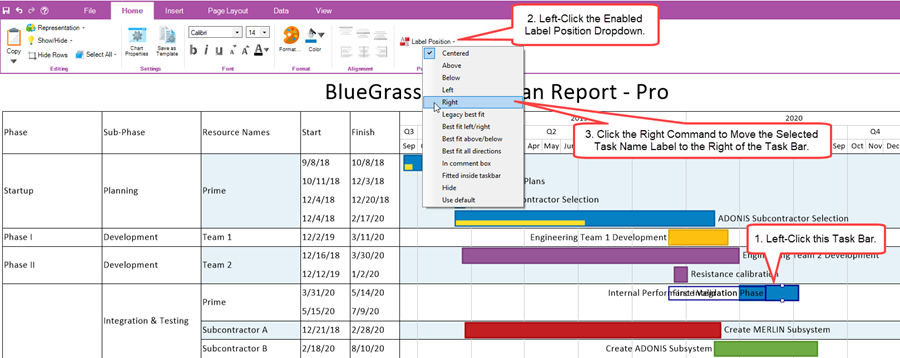
When the action is completed the selected task bar's name label is positioned to the Right of the task bar:

The steps taken above are the same steps available with OnePager before version 7.0.
Change to Task Bar and Name Label Selection Methods in OnePager Pro and Express 7.0
As part of the Smart Text Optimization feature's implementation, we changed the task bar and task bar name label manual left-click and right-click selection rules as follows:
Left-Click Selection Rules
To select a task bar in OnePager 7.0 you left-click the task bar itself. To select the task bar's name label left-click the task bar name label only.
Right-Click Selection Rules
A right-click on a task bar accesses a context menu with commands that are associated with edits to the task bar and the task bar name label as shown below:
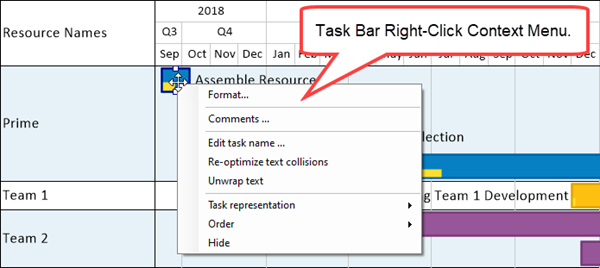
A right-click on a task bar name label accesses a specific context menu with commands that are primarily for edits to the task bar name label as shown here:

Both right-click context menus have commands that allow the editing of task bar name labels and for re-optimizing name labels in collision.
Select Associated Text Options
Since the above represents a change from previous versions of OnePager Pro and Express with respect to selecting task bars and task bar name labels, OnePager 7.0 provides a option for setting the behavior of task bar selection to that of previous versions. This option is controlled by a checkbox in the Advanced tab of the Template and Chart Properties forms in the Display options control group called Select associated text shown below:
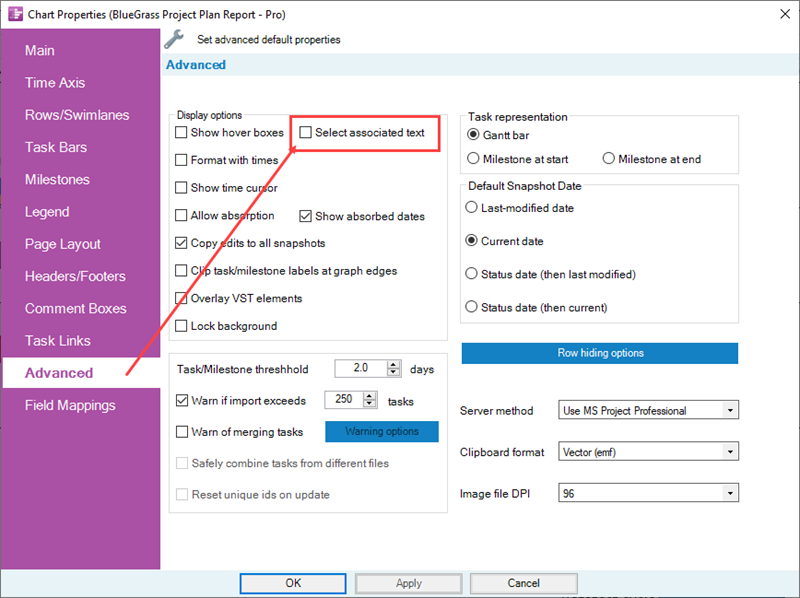
The default setting in the checkbox is checked ON. Checking this checkbox to ON changes the behavior of a left-click on a task bar such that the left-click selects both the task bar and the task bar name label. Checking the Select associated text checkbox OFF, changes the behavior of a left-click on a task bar or milestone symbol so that the left-click selects the task bar or milestone symbol only. Left-clicking on a task bar name label selects the task bar name label only. Regardless of the setting in the Select associated text checkbox, there is no difference in how the right-click on a task bar and/or task bar name label operates.
Changes to Task Bar and Task Bar Name Label Right-Click Context Menus
The changes to task bar and task bar name label selection described above offers an opportunity to enhance the context menus associated with task bars and task bar name labels. The right-click on task bar context menu contains commands available in previous versions of OnePager Pro and Express with the addition of a new command associated with the Smart Text Optimization feature - the Re-optimize text collisions command shown below;

This new context menu command is explained in greater detail in the Wiki articles referenced below. The right click on a task bar name label accesses a context menu shown below with four (4) commands that allows you to:
- Edit the task bar name label
- Access the Change Task/Milestone Properties form at the Task Label tab
- Perform a manual re-optimization of task bar name labels in collision
- Unwrap task bar name labels previously wrapped as a result of the re-optimization of task bar name labels in collision .

The above context menu allows you to edit the name label and to access the Change Task/Milestone Properties form at the Task Label tab shown here:
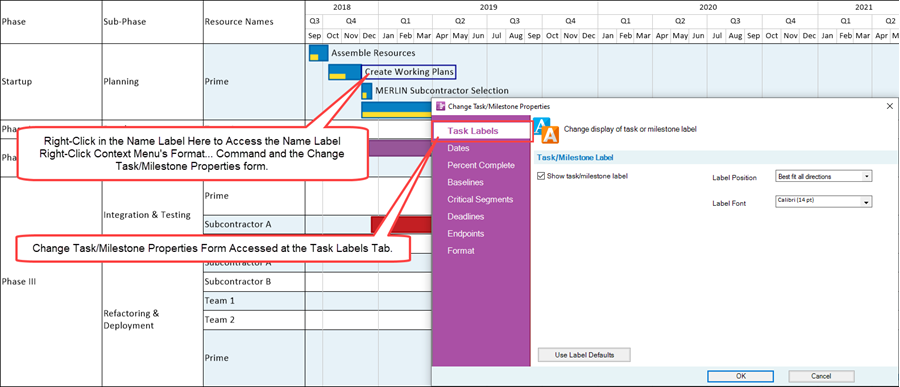
As in previous OnePager versions this form allows you to turn the display of task bar name labels ON and OFF, change their positions relative to their task bar, and change their font properties. Please note that the default Label Position is Best fit all directions representing a change from the defaults used in previous versions of OnePager Pro and Express.
Using The Smart Text Optimization Feature
The Smart Text Optimization feature in OnePager 7.0 provides more automated ways to tidy up a chart where task bar task bar name labels are in collision. To illustrate this let us consider the situation found in the example from this section: Manual Method for Resolving Task Bar Name Label Collisions. 0.4.2-70
Using your mouse to select both task bars with the CTL+Left-Shift action and then right-clicking on one of the two selected task bars accesses the context menu shown below with the new command for fixing this task bar name label collision situation:
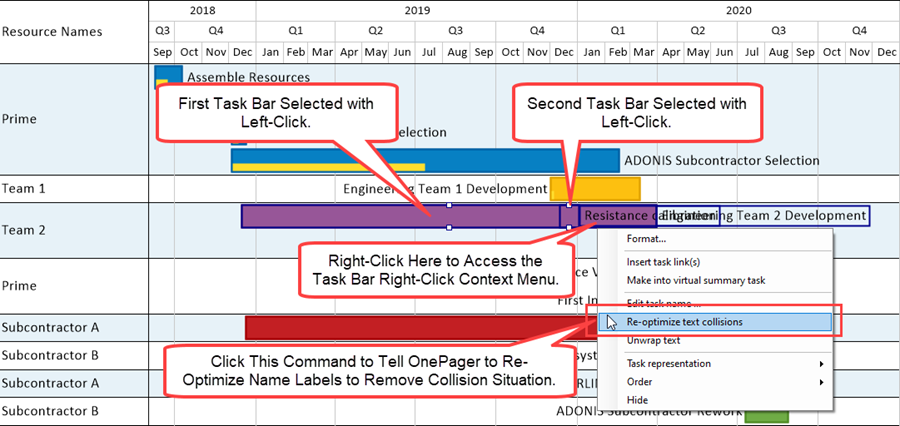
At the completion of the action, the task bar name labels for each of the selected task bars look like this:

The purpose of implementing this feature is to give you control over how OnePager 7.0 fixes task bar name label collision situations. OnePager 7.0 comes to your assistance when you select one or more task bars where their task bar name label(s) are in collision. Once you make the desired selections, the Re-optimize text collisions command is available and tells OnePager 7.0 to re-optimize the selected task bar's name labels so they avoid the collision situation. These task bar name label positions are either established by default in your Template Properties form or you can change the positions of selected task bar name label using the OnePager Home ribbon tool bar tab's controls or the Change Task/Milestone Properties form at the Task Label tab.
OnePager has always supported your ability to place task bar name labels with respect to their task bar Above, Below, Left, Right, Centered, Best fit left/right, Fit in task bar, and In Comment Box. We added three (3) additional position options for you to tell OnePager 7.0 where to position task bar name labels to support this feature. These three addition position options are:
- Best fit all directions' which tells OnePager to consider the possibility of positioning the task bar name label for the selected task bar Above, Below, Left, or Right the task bar.
- Best fit above/below which tells OnePager to examine the possibility of positioning the task bar name label for the task bar selected Above or Below the task bar.
- The Legacy best fit can be used when a chart is imported from a previous version of OnePager Pro or Express and task bar name label positions are imported from that previous version.
Below is the list of name label position options from the OnePager 7.0 Home ribbon tool bar tab's Label Positions control group:
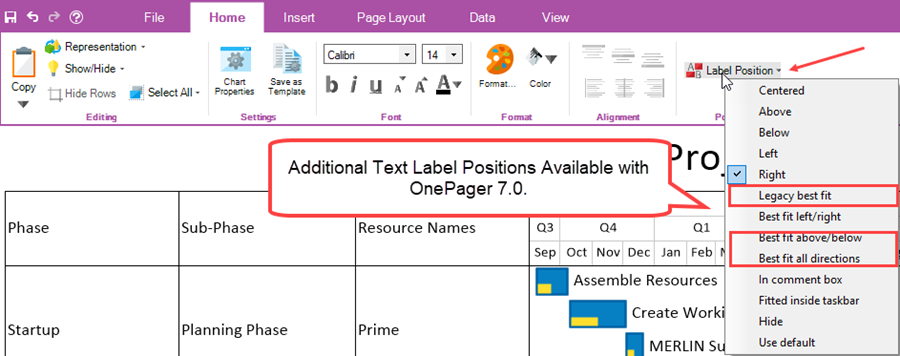
With the addition of the Smart Text Optimization feature, OnePager 7.0 is released with its standard Template Properties forms preset to position task bar name labels using the Best fit all directions option. Where possible in OnePager 7.0, where there is a label position option to be taken, OnePager 7.0 distributed Template Properties forms include the Best fit all directions as the default. When Template Properties forms are brought forward from previous versions of OnePager Pro or Express, OnePager 7.0 does NOT change any Label Position options previously set in your previously used Template Properties forms. For more information on sharing charts and Template Properties forms between OnePager 7.0 and previous versions, please see these articles: Sharing Charts (Portal) 23.2.1-70 and Sharing Charts with Older Versions of OnePager 23.2.3.1-70.
Avoiding Task Bar Name Label Collisions
OnePager 7.0 employs a Text Label Collision Avoidance algorithm to perform the re-optimization operation under priorities you control. OnePager 7.0 automatically attempt to re-optimize task bar name label positions when collisions are present and the feature is turned ON (which is the default). The automatic re-optimization of task bar name label positions also takes place during certain chart update operations. You can initiate the algorithm manually by first selecting the one or more task bars involved with task bar name label collision situations and then clicking the Re-optimize text collisions command in the right-click context menu provided as shown in the example in the previous section above.
The minimum conditions necessary for OnePager 7.0 to apply the text label collision avoidance algorithm are:
- There must be at least one task bar where its respective task bar name label is in collision.
- All the task bars involved must be capable of being selected with a left-click.
It is possible to invoke the text label collision avoidance algorithm when there are no task bar name labels in a collision situation. In this case, nothing appears to happen in the chart when the Re-optimize text collisions command is clicked. OnePager 7.0 provides a notice the lower right corner of the Chart Editor that says No label collisions detected.
User Control over Smart Task Bar Text Labeling
As mentioned above, you have control over the Text Label Collision Avoidance Algorithm with controls available in the Template Properties and Chart Properties form's Task Bars, and Milestone tabs. The text label collision avoidance algorithm employs four (4) methods, called Escape Methods for fixing or avoiding task bar name label collision situations and are explained below. These controls are available in the Set Label Properties form found at the Task Bars and Milestones tabs in the Template Properties form and Chart Properties form as shown below:
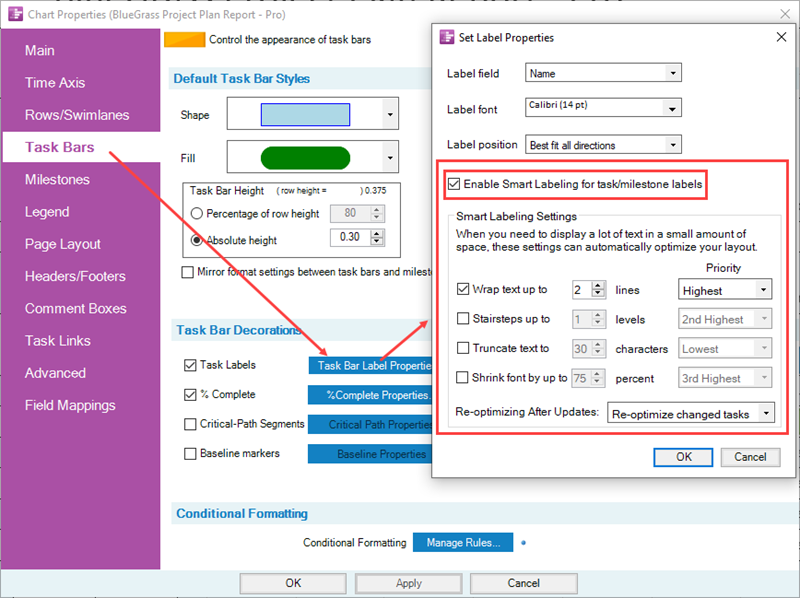
The Enable Smart Labeling for task/milestones labels checkbox enables or disables the feature. As a convention, all Template Properties forms provided with OnePager 7.0 have this checkbox checked ON. When enabled, the four (4) sets of checkboxes and selection windows give you the capability to establish your own task bar name labeling algorithm priorities. The Wrap text setting shown above is the default setting provided with OnePager 7.0. The four checkboxes in the Set Label Properties form's Smart Labeling Setting control group allow you to turn ON and OFF the available Escape Methods for fixing or avoiding task bar name label collisions. The four Escape Methods available are described below:
- When the Wrap text escape method is enabled, you can specify the maximum number of lines you want OnePager 7.0 to use before truncating the remainder of the task bar name label's content.
- When the Stairstep escape method is enabled, you can specify the maximum number of levels OnePager 7.0 can attach to the task bar involved in the process. A task bar name label in a Stairstep configuration looks like this:
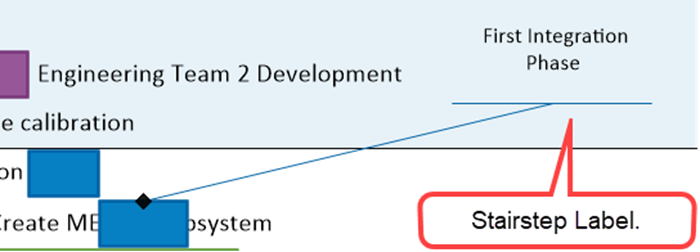
- When the Truncate Text escape method is enabled, you can specify the maximum number of characters in the task bar name label you want OnePager 7.0 to display before discarding the remaining characters to the right.
- When the Shrink Font escape method is enabled, you can specify the percentage of shrinkage you want to allow OnePager 7.0 to shrink the font size of the original text to fit into the allowable space.
The Priority selection windows to the right of each Escape Method are enabled when the Escape Method's checkbox is checked ON. The options available permit you to specify the priority ordering you desire OnePager 7.0 to follow when applying the text label collision avoidance algorithm using the four available Escape Methods. The dropdown options for the Priority selection looks like this:
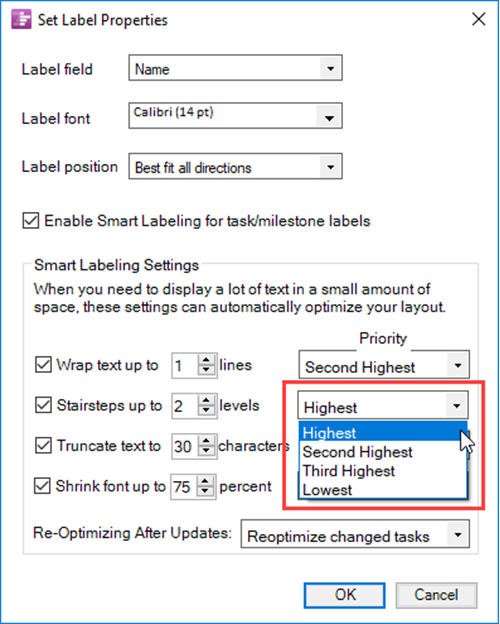
OnePager 7.0 only lets you set one priority per Escape Method so you must decide which of the four Escape Methods is your Highest, Lowest, and in between. This requires some experimentation as charts differ with source plan input content and formatting. Once determined, the Priority settings should remain acceptable for snapshots created from the same Updated source plan. An important capability of the Smart Text Optimization feature is that it automatically re-optimizes task bar name labels in collision situations when a chart UPDATE is performed. The most typical UPDATE is to Replace a Snapshot in one of the three replacement modes available. Snapshot replacement modes are described in the articles found at: Basic Workflows (Portal) 7.0.1-70
This capability is provided automatically when the Smart Task/Milestone Text Labeling feature is enabled as described above. The Re-Optimizing After Updates selection window provides three (3) options for controlling how OnePager 7.0 re-optimizes after you UPDATE the chart at the snapshot level by using one of the replacement modes available with OnePager. The three options are shown below:
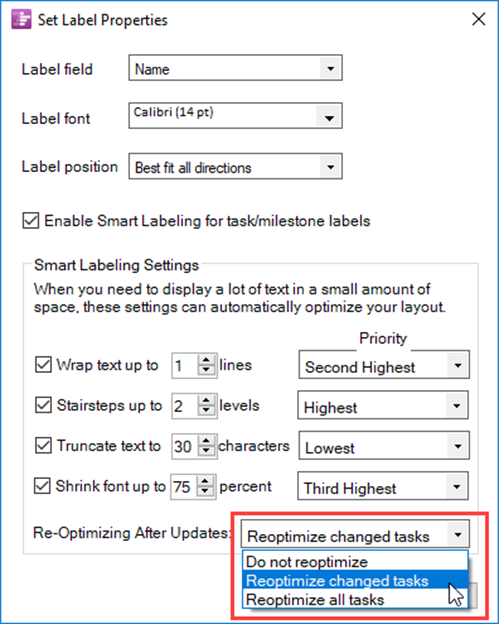
- Reoptimize changed tasks' is the default setting and re-optimizes those task bar name labels that changed as a result of the Replace snapshot operation. The term “changed tasks” refers primarily to those source plan tasks that changed in some manner such as a change to the Task Name or to a Start/Finish date as examples and for which the Replace snapshot action is intended to accommodate. Any changes to task bar attributes in the chart that also result in a task bar name label collision such as moving a task bar into another row or swimlane is subject to reoptimization with this setting.
- The Do not reoptimize option disregards any changes to the chart where there are task bar name label collision situations and UPDATES the chart in the Chart Editor. This option effectively turns OFF the feature.
- The Reoptimize all tasks option applies the text label collision avoidance algorithm on all task bars involved in a Replace snapshot operation regardless of whether there are “changed tasks” or not.
A simple example is the case where a task bar with a short task bar name label is moved into an occupied row but does not cause a name label collision situation. In this case any application of the text label collision avoidance algorithm does not change the appearance of the chart. Now, after making the task bar row move, go back to the source plan where you change the length of the Task Name field for the task bar that you previously moved to a different row. In order to apply this source plan update, you must go to the Chart Editor’s Data ribbon tool bar tab and click the Custom Update… button. This action accesses the OnePager choices form where the All properties Replacement mode button is clicked followed by a click on the form’s OK button. The result of this Replace snapshot (All properties mode) action is to UPDATE the chart so that the lengthened task bar name label is imported. Since the lengthened task bar name label now causes a task bar name label collision situation the text label collision avoidance algorithm is invoked. The final result is that the text label collision avoidance algorithm removes all task bar name label collision situations through the application of the appropriate Escape Method.
The Smart Text Optimization feature with its controls are discussed in detail in the article referenced below and elsewhere in this Wiki.
Related Links
New Task/Milestone Shape and Text Label Selection Rules 0.4.2.3-70
Basic Workflows (Portal) 7.0.1-70
Modifying Decorations on Tasks/Milestones (Portal) 10.0.1-70
Task Labels for OnePager Pro 10.15.1-70
Task Bar Name Labels for OnePager Express 10.16.1-70
Labeling Task/Milestone Dates for OnePager Pro 10.1.1-70
Labeling Task/Milestone Dates for OnePager Express 10.2.1-70
Percent complete for OnePager Pro 10.3.1-70
Percent complete for OnePager Express 10.4.1-70
Order of Tasks/Milestones Decorations 10.13.1-70
Task Bars Tab for OnePager Pro 21.3.1-70
Task Bars Tab for OnePager Express 21.4.1-70
Milestones Tab for OnePager Pro 21.5.1-70
Milestones Tab for OnePager Express 21.6.1-70
(0.4.2-70)